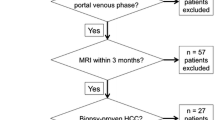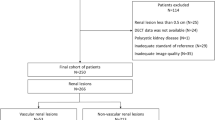Abstract
Background
One of the main features of liver fibrosis is the expansion of the interstitial space. All water-soluble CT contrast agents remain confined in the vascular and interstitial space constituting the fractional extracellular space (fECS). Indirect measure of its expansion can be quantified during equilibrium phase with CT. The goal of this prospective study was to assess the feasibility of dual-energy CT (DECT) with iodine quantification at equilibrium phase in the evaluation of significant fibrosis or cirrhosis.
Methods
Thirty-eight cirrhotic patients (according to Child–Pugh and MELD scores), scheduled for liver CT, were enrolled in the study group. Twenty-four patients undergoing CT urography with a 10-min excretory phase were included in the control group. fECS was calculated as the ratio of the iodine concentration of liver parenchyma to that of the aorta, multiplied by 1 minus hematocrit.
Results
Final study and control group were, respectively, composed of 22 and 20 patients. Mean hepatic fECS value was statistically greater in study group (P < 0.05). Positive correlation was observed between hepatic fECS value and MELD score (r = 0.64, P < 0.05). Analysis of variance showed statistical differences between control group and the Child–Pugh grades and between Child–Pugh A and B patients and Child–Pugh C patients (P < 0.05). ROC curves analysis yielded an optimum fECS cutoff value of 26.3% for differentiation of control group and cirrhotic patients (AUC 0.88; 86% sensitivity, 85% specificity).
Conclusions
Dual-source DECT is a feasible, noninvasive method for the assessment of significant liver fibrosis or cirrhosis.




Similar content being viewed by others
References
Bataller R, Brenner DA (2005) Liver fibrosis. J Clin Invest 115:209–218. https://doi.org/10.1172/JCI24282
Albanis E, Friedman SL (2001) Hepatic fibrosis. Clin Liver Dis 5:315–334. https://doi.org/10.1016/S1089-3261(05)70168-9
Friedman SL (2008) Mechanisms of hepatic fibrogenesis. Gastroenterology 134:1655–1669. https://doi.org/10.1053/j.gastro.2008.03.003
Tsochatzis EA, Bosch J, Burroughs AK (2014) Liver cirrhosis. The Lancet 383:1749–1761. https://doi.org/10.1016/S0140-6736(14)60121-5
Horowitz JM, Venkatesh SK, Ehman RL et al (2017) Evaluation of hepatic fibrosis: a review from the society of abdominal radiology disease focus panel. Abdom Radiol 42:2037–2053. https://doi.org/10.1007/s00261-017-1211-7
Bandula S, Punwani S, Rosenberg WM et al (2015) Equilibrium contrast-enhanced CT imaging to evaluate hepatic fibrosis: initial validation by comparison with histopathologic sampling. Radiology 275:136–143. https://doi.org/10.1148/radiol.14141435
Regev A, Berho M, Jeffers LJ et al (2002) Sampling error and intraobserver variation in liver biopsy in patients with chronic HCV infection. Am J Gastroenterol 97:2614–2618. https://doi.org/10.1111/j.1572-0241.2002.06038.x
Zissen MH, Wang ZJ, Yee J et al (2013) Contrast-enhanced CT quantification of the hepatic fractional extracellular space: correlation with diffuse liver disease severity. AJR Am J Roentgenol 201:1204–1210. https://doi.org/10.2214/AJR.12.10039
Lamb P, Sahani DV, Fuentes-Orrego JM et al (2015) Stratification of patients with liver fibrosis using dual-energy CT. IEEE Trans Med Imaging 34:807–815. https://doi.org/10.1109/TMI.2014.2353044
Yoon JH, Lee JM, Klotz E et al (2015) Estimation of hepatic extracellular volume fraction using multiphasic liver computed tomography for hepatic fibrosis grading. Invest Radiol 50:290–296. https://doi.org/10.1097/RLI.0000000000000123
Varenika V, Fu Y, Maher JJ et al (2013) Hepatic fibrosis: evaluation with semiquantitative contrast-enhanced CT. Radiology 266:151–158. https://doi.org/10.1148/radiol.12112452
Guo SL, Su LN, Zhai YN et al (2017) The clinical value of hepatic extracellular volume fraction using routine multiphasic contrast-enhanced liver CT for staging liver fibrosis. Clin Radiol 72:242–246. https://doi.org/10.1016/j.crad.2016.10.003
Robinson E, Babb J, Chandarana H, Macari M (2010) Dual source dual energy MDCT: comparison of 80 kVp and weighted average 120 kVp data for conspicuity of hypo-vascular liver metastases. Invest Radiol. https://doi.org/10.1097/RLI.0b013e3181dfda78
Altenbernd J, Heusner TA, Ringelstein A et al (2011) Dual-energy-CT of hypervascular liver lesions in patients with HCC: investigation of image quality and sensitivity. Eur Radiol 21:738–743. https://doi.org/10.1007/s00330-010-1964-7
Marin D, Ramirez-Giraldo JC, Gupta S et al (2016) Effect of a noise-optimized second-generation monoenergetic algorithm on image noise and conspicuity of hypervascular liver tumors: an in vitro and in vivo study. Am J Roentgenol 206:1222–1232. https://doi.org/10.2214/AJR.15.15512
Ascenti G, Sofia C, Silipigni S et al (2015) Dual-energy multidetector computed tomography with iodine quantification in the evaluation of portal vein thrombosis: is it possible to discard the unenhanced phase? Can Assoc Radiol J 66:348–355. https://doi.org/10.1016/j.carj.2015.04.001
Lv P, Lin X, Gao J, Chen K (2012) Spectral CT: preliminary studies in the liver cirrhosis. Korean J Radiol 13:434. https://doi.org/10.3348/kjr.2012.13.4.434
Zhao L, He W, Yan B et al (2013) The evaluation of haemodynamics in cirrhotic patients with spectral CT. Br J Radiol 86:20130228. https://doi.org/10.1259/bjr.20130228
Kamath PS, Wiesner RH, Malinchoc M et al (2001) A model to predict survival in patients with end-stage liver disease. Hepatol Baltim Md 33:464–470. https://doi.org/10.1053/jhep.2001.22172
Kalra A, Wedd JP, Biggins SW (2016) Changing prioritization for transplantation: MELD-Na, hepatocellular carcinoma exceptions, and more. Curr Opin Organ Transplant 21:120–126. https://doi.org/10.1097/MOT.0000000000000281
Marin D, Boll DT, Mileto A, Nelson RC (2014) State of the art: dual-energy CT of the Abdom. Radiology 271:327–342. https://doi.org/10.1148/radiol.14131480
Biondi M, Vanzi E, De Otto G et al (2016) Water/cortical bone decomposition: a new approach in dual energy CT imaging for bone marrow oedema detection. A feasibility study. Phys Med 32:1712–1716. https://doi.org/10.1016/j.ejmp.2016.08.004
Forghani R, De Man B, Gupta R (2017) Dual-energy computed tomography: physical principles, approaches to scanning, usage, and implementation: part 1. Neuroimaging Clin N Am 27:371–384. https://doi.org/10.1016/j.nic.2017.03.002
Ascenti G, Sofia C, Mazziotti S et al (2016) Dual-energy CT with iodine quantification in distinguishing between bland and neoplastic portal vein thrombosis in patients with hepatocellular carcinoma. Clin Radiol 71:938.e1–938.e9. https://doi.org/10.1016/j.crad.2016.05.002
Mazzei MA, Gentili F, Volterrani L (2019) Dual-energy CT iodine mapping and 40-keV monoenergetic applications in the diagnosis of acute bowel ischemia: a necessary clarification. AJR Am J Roentgenol 212:W93–W94. https://doi.org/10.2214/AJR.18.20501
Sofue K, Tsurusaki M, Mileto A et al (2018) Dual-energy computed tomography for non-invasive staging of liver fibrosis: accuracy of iodine density measurements from contrast-enhanced data: staging of liver fibrosis in dual-energy CT. Hepatol Res. https://doi.org/10.1111/hepr.13205
Marin D, Pratts-Emanuelli JJ, Mileto A et al (2015) Interdependencies of acquisition, detection, and reconstruction techniques on the accuracy of iodine quantification in varying patient sizes employing dual-energy CT. Eur Radiol 25:679–686. https://doi.org/10.1007/s00330-014-3447-8
Koonce JD, Vliegenthart R, Schoepf UJ et al (2014) Accuracy of dual-energy computed tomography for the measurement of iodine concentration using cardiac CT protocols: validation in a phantom model. Eur Radiol 24:512–518. https://doi.org/10.1007/s00330-013-3040-6
Euler A, Solomon J, Mazurowski MA et al (2019) How accurate and precise are CT based measurements of iodine concentration? A comparison of the minimum detectable concentration difference among single source and dual source dual energy CT in a phantom study. Eur Radiol 29:2069–2078. https://doi.org/10.1007/s00330-018-5736-0
Funding
This study did not receive any funding.
Author information
Authors and Affiliations
Corresponding author
Ethics declarations
Conflict of interest
Antonio Bottari declares that he has no conflict of interest. Salvatore Silipigni declares that he has no conflict of interest. Maria Ludovica Carerj declares that she has no conflict of interest. Antonino Cattafi declares that he has no conflict of interest. Sergio Maimone declares that he has no conflict of interest. Maria Adele Marino declares that she has no conflict of interest. Silvio Mazziotti declares that he has no conflict of interest. Alessia Pitrone declares that she has no conflict of interest. Giovanni Squadrito declares that he has no conflict of interest. Giorgio Ascenti declares that he has no conflict of interest.
Ethical approval
This article does not contain any studies with animals performed by any of the authors. All procedures performed on human participants were in accordance with the ethical standards of the institutional research committee and with the 1964 Helsinki Declaration and its later amendments or comparable ethical standards.
Informed consent
Informed consent was obtained from all individual participants included in the study.
Additional information
Publisher's Note
Springer Nature remains neutral with regard to jurisdictional claims in published maps and institutional affiliations.
Rights and permissions
About this article
Cite this article
Bottari, A., Silipigni, S., Carerj, M.L. et al. Dual-source dual-energy CT in the evaluation of hepatic fractional extracellular space in cirrhosis. Radiol med 125, 7–14 (2020). https://doi.org/10.1007/s11547-019-01089-7
Received:
Accepted:
Published:
Issue Date:
DOI: https://doi.org/10.1007/s11547-019-01089-7




